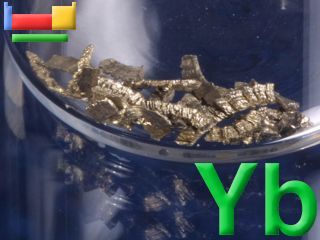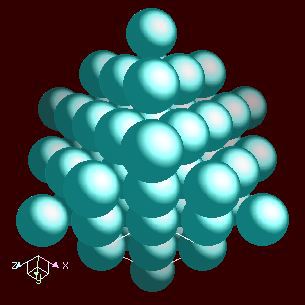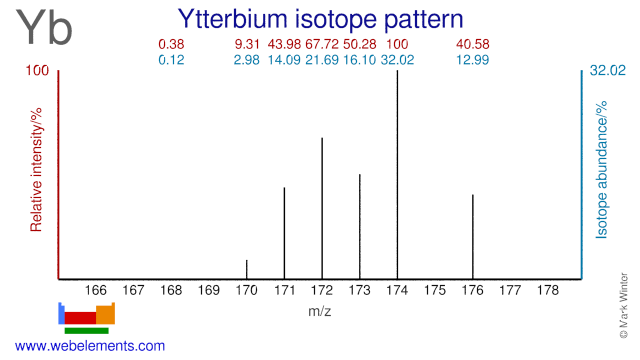Ytterbium - 70Yb: the essentials
- Name: ytterbium
- Symbol: Yb
- Atomic number: 70
- Relative atomic mass (Ar): 173.045 (10) g [see note g]
- Standard state: solid at 298 K
- Appearance: silvery white
- Classification: Metallic
- Group in periodic table:
- Group name: Lanthanoid
- Period in periodic table: 6 (lanthanoid)
- Block in periodic table: f
- Shell structure: 2.8.18.32.8.2
- CAS Registry: 7440-64-4
Ytterbium atoms have 70 electrons and the shell structure is 2.8.18.32.8.2. The ground state electronic configuration of neutral ytterbium is [Xe].4f14.6s2 and the term symbol of ytterbium is 1S0.
Ytterbium: description
Ytterbium has a bright silvery lustre, is soft, malleable, and quite ductile. While the element is fairly stable, it should be kept in closed containers to protect it from air and moisture. Ytterbium is readily attacked and dissolved by mineral acids and reacts slowly with water.

This sample is from The Elements Collection, an attractive and safely packaged collection of the 92 naturally occurring elements that is available for sale.
Ytterbium: physical properties
Density of solid: 6570 kg m-3
Molar volume: 24.84 cm3
Thermal conductivity: 34.9 W m‑1 K‑1
Ytterbium: heat properties
Melting point: 1097 [824 °C (1515 °F)] K
Boiling point: 1469 [1196 °C (2185 °F)] K
Enthalpy of fusion: 20.5 kJ mol-1
Ytterbium: atom sizes
Atomic radius (empirical): 175 pm
Molecular single bond covalent radius: 170 (coordination number 3) ppm
van der Waals radius: 274 ppm
Ytterbium: electronegativities
Pauling electronegativity: (no data) (Pauling units)
Allred Rochow electronegativity: 1.06 (Pauling units)
Mulliken-Jaffe electronegativity: (no data)
Ytterbium: orbital properties
First ionisation energy: 603.43 kJ mol‑1
Second ionisation energy: 1175.11 kJ mol‑1
Third ionisation energy: 2417.2 kJ mol‑1
Ytterbium: abundances
Universe: 2 ppb by weight
Crustal rocks: 2800 ppb by weight
Human: (no data) ppb by weight
Ytterbium: crystal structure

Ytterbium: biological data
Human abundance by weight: (no data) ppb by weight
Ytterbium has no biological role but is said to stimulate the metabolism.
Ytterbium: uses
Ytterbium: reactions
Reactions of ytterbium as the element with air, water, halogens, acids, and bases where known.
Ytterbium: binary compounds
Binary compounds with halogens (known as halides), oxygen (known as oxides), hydrogen (known as hydrides), and other compounds of ytterbium where known.
Ytterbium: compound properties
Bond strengths; lattice energies of ytterbium halides, hydrides, oxides (where known); and reduction potentials where known.
Ytterbium: history
Ytterbium was discovered by Jean de Marignac in 1878 at Switzerland. Origin of name: named after the village of "Ytterby" near Vaxholm in Sweden.Ytterbium: isotopes

Ytterbium has seven stable isotopes and two of them are used for medical and industrial purposes. Yb-168 is used for the production of Yb-169 and this radioisotope is used as a radiation source in gamma cameras. Yb-169 is also used in the medical field where it has been proposed as an alternative for I-125 and Pd-103 in the treatment of prostate cancer while it is also used for diagnostics in the gastrointestinal tract. Yb-176 can be used as a target for the production of carrier-free Lu-177 with a high specific activity. Yb-171 in an excited state has been proposed as an optical frequency standard, while the other Yb isotopes are used in various physics experiments.
Ytterbium: isolation
Isolation: ytterbium metal is available commercially so it is not normally necessary to make it in the laboratory, which is just as well as it is difficult to isolate as the pure metal. This is largely because of the way it is found in nature. The lanthanoids are found in nature in a number of minerals. The most important are xenotime, monazite, and bastnaesite. The first two are orthophosphate minerals LnPO4 (Ln deonotes a mixture of all the lanthanoids except promethium which is vanishingly rare) and the third is a fluoride carbonate LnCO3F. Lanthanoids with even atomic numbers are more common. The most comon lanthanoids in these minerals are, in order, cerium, lanthanum, neodymium, and praseodymium. Monazite also contains thorium and ytrrium which makes handling difficult since thorium and its decomposition products are radioactive.
For many purposes it is not particularly necessary to separate the metals, but if separation into individual metals is required, the process is complex. Initially, the metals are extracted as salts from the ores by extraction with sulphuric acid (H2SO4), hydrochloric acid (HCl), and sodium hydroxide (NaOH). Modern purification techniques for these lanthanoid salt mixtures are ingenious and involve selective complexation techniques, solvent extractions, and ion exchange chromatography.
Pure ytterbium is available through the electrolysis of a mixture of molten YbCl3 and NaCl (or CaCl2) in a graphite cell which acts as cathode using graphite as anode. The other product is chlorine gas.
